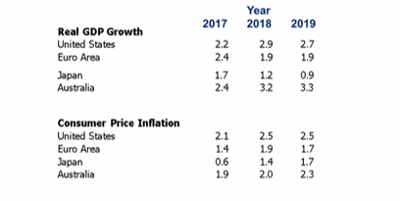This time last year, almost nobody forecast that the US economy would be growing as strongly as it is. The expected result for this year was around 2.2% growth, falling to around 1.8% growth in 2019. This slowdown was expected to result from the gradual tightening of short term interest rates by the US Federal Reserve. Very few economists included a major surge in growth as a result of US tax cuts. Still, that major surge in growth is what has occurred.
Figure 1: Global Economic Perspective

SOURCE: Morgans
Advertisement
Instead of 2.2% growth in 2018, the US economy looks like achieving not less than 2.9% growth. Some estimates for the year, including the fourth quarter GDPNow, produced by the Federal Reserve Bank of Atlanta, suggests that GDP growth will finish this year at around 3%.
Tax cuts have increased growth in two ways. The first is that reduction in corporate taxes has allowed firms to retain more earnings to invest. The second is that cuts in personal income tax have provided workers with increased after tax earnings. This has generated an increase in labour force participation and allowed the unemployment rate to fall with no increase in inflation. Both of these effects are what economists call 'supply side effects'.
We think that these supply side effects from corporate and private tax cuts will have a long term positive effect on both US corporate investment and labour force participation for a number of US economic cycles. The result should not just be stronger than anticipated growth now, but an increase in the average growth rate of the US economy over at least the next few business cycles.
This means that US business cycles will be shorter, the average level of unemployment will be lower and real wage growth will be higher. This movement back to a stronger economy with lower inflation will generate a US economy which will be an entirely different experience than that which the US workforce has endured in recent memory.
The Euro Area
In the press conference, following the meeting of the Governing Council of the European Central Bank, the President of the ECB, Dr Mario Draghi, said that the European economy had had downside risks because of weakness of international trading partners. These downside risks appear to be receding. He estimated that growth this year in the Euro Area would be 1.9%. He thought that this might decline in 2019 to 1.7%. Our view is that growth will be a stronger than anticipated 1.9% in 2019.
Advertisement
The European Central Bank has brought an end to its program of quantitative easing at the end of December 2018. However, it still remains with a strongly expansive monetary policy. In spite of inflation now reaching the target level of around 2%, the European Central Bank deposit rate remains at -40 basis points. This means the Euro Area now has a policy short term interest rate which is -2.4% in real terms. Our view is that this provides the basis for better than anticipated expansion of the Euro Area in the year ahead.
Japan
Japan has already reached full employment. This means any growth in the Japanese economy is from increased productivity. Given this limitation, Japanese growth is surprisingly high. We think that Japanese output will grow by 1.2% in 2018. In 2019 Japanese growth should be 0.9%.
This article was first published by Morgans.
The information contained in this report is provided to you by Morgans Financial Limited as general advice only, and is made without consideration of an individual’s relevant personal circumstances. Morgans Financial Limited ABN 49 010 669 726, its related bodies corporate, directors and officers, employees, authorised representatives and agents (“Morgans”) do not accept any liability for any loss or damage arising from or in connection with any action taken or not taken on the basis of information contained in this report, or for any errors or omissions contained within. It is recommended that any persons who wish to act upon this report consult with their Morgans investment adviser before doing so. Those acting upon such information without advice do so entirely at their own risk.
This report was prepared as private communication to clients of Morgans and is not intended for public circulation, publication or for use by any third party. The contents of this report may not be reproduced in whole or in part without the prior written consent of Morgans. While this report is based on information from sources which Morgans believes are reliable, its accuracy and completeness cannot be guaranteed. Any opinions expressed reflect Morgans judgement at this date and are subject to change. Morgans is under no obligation to provide revised assessments in the event of changed circumstances. This report does not constitute an offer or invitation to purchase any securities and should not be relied upon in connection with any contract or commitment whatsoever.
Discuss in our Forums
See what other readers are saying about this article!
Click here to read & post comments.
24 posts so far.